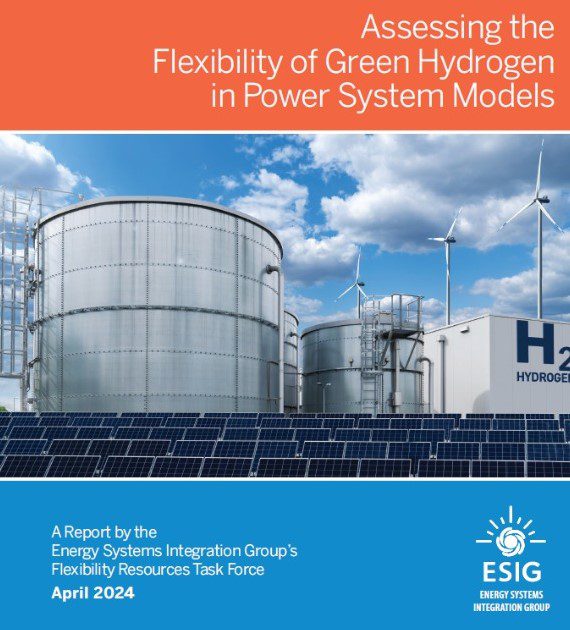Exploring the Modeling Needs and Data Requirements to Integrate Green Hydrogen into Power System Studies

Hydrogen production and use can store energy for use in many time frames (from seconds to seasons), has a rapid response time as a flexible load, and offers the potential for large-scale deployment
Reston, Va. – The Energy Systems Integration Group (ESIG) has released a new report, Assessing the Flexibility of Green Hydrogen in Power System Models, that explores the modeling needs and data requirements to integrate hydrogen into power system studies.
As levels of wind and solar rise, power systems will require different types of flexibility to balance supply and demand and maintain reliability. Green hydrogen production has the potential to provide such flexibility, either by stand-alone hydrogen production that behaves as a flexible load or by using hydrogen to produce electricity via a fuel cell or combustion engine. Hydrogen has the ability to store energy for use in many time frames (from seconds to seasons), a rapid response time, and the potential for large-scale deployment.
“While the amount of electrolytic hydrogen used in the power system of the future is unclear, it is clear that it can play a fundamental role in providing power system flexibility,” said Anna Lafoyiannis, technical leader at the independent, non-profit energy R&D institute EPRI, and ESIG task force chair. “Developing robust tools and supporting data to model all the ways that electrolytic hydrogen can support the power system is an important step to unlocking future flexibility.”
Modeling the flexibility of hydrogen introduces new considerations beyond what power system models have typically incorporated. Such modeling is a complex effort, with many options and permutations of potential electrolysis systems, operating regimes, and grid services to target. Modelers will need to consider what grid services are needed in a given area, what tools can best assess these services, what electrolysis system is best suited for providing the services, what data sources are available to develop modeling inputs, and how the dynamics between hydrogen and electric power markets can be considered.
The report discusses gaps in existing power system modeling tools and methods, and is intended as a starting point for modelers to consider how to evaluate the benefits and implications of using green hydrogen production to provide flexibility in their systems. It outlines various needs, including improving the availability and quality of data for hydrogen production and demand, enhancing modeling capabilities and resolution, and exploring the value streams and trade-offs of hydrogen production for different end uses.
ESIG is a nonprofit organization that marshals the expertise of the electricity industry’s technical community to support grid transformation and energy systems integration and operation. The report can be downloaded at https://www.esig.energy/green-hydrogen-in-power-system-models/.


